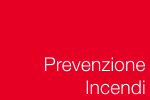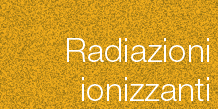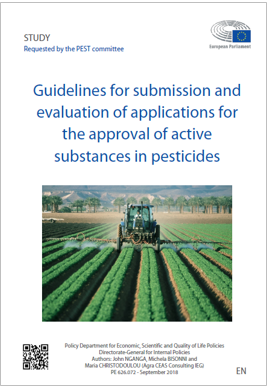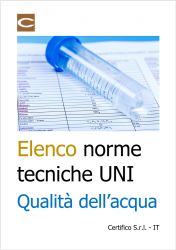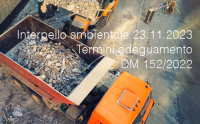Guidelines applications for the approval of active substances in pesticides
| ID 9525 | | Visite: 2185 | Documenti Ambiente UE | Permalink: https://www.certifico.com/id/9525 |
Guidelines for submission and evaluation of applications for the approval of active substances in pesticides
Plant protection products (PPPs) – a subset of pesticides – must contain at least one active substance to be authorised. EU legislation defines an active substance as “a substance or a micro-organism that has an action on or against harmful organisms”.
An applicant who wishes to obtain approval for an active substance must submit a dossier through a selected national contact point. This dossier contains an extensive set of documentation, which provides the data necessary to carry out the risk assessment.
EU legislation sets out data requirements to be included in application dossiers for active substance approval. Guidance can be technical (scientific) or procedural. Technical guidance provides more detail on what must be done in practical terms to check/fulfil these data requirements and hence effectively act as sub-requirements for approval when used.
Procedural guidance provides further clarifications on the procedure itself, rather than the scientific data. Furthermore, Test guidelines (or test methods) are protocols to follow when performing tests as part of studies to fulfil the data requirements set in the EU legislation.
Approval of active substances occurs at EU level; therefore, EU level guidance should be used. The existence of EU-level guidance eventually ensures the harmonisation of the evaluation and risk assessment procedures at the Union level.
Guidance may be used:
- during the peer review process conclusions which is co-ordinated by EFSA (EFSA is also responsible for drafting the conclusions of this process).
As guidance documents are used during the risk assessment stage, they can be considered to be of relevance for applicants, whose dossiers must successfully navigate this stage on the way to possibly ultimate approval.
The Communication to Regulation (EC) No 283/2013 serves the role of indicating technical guidance and guidelines relevant for the approval of active substances. Relevant technical guidance and guidelines are indicated by data requirements for the dossier to be submitted for approval. However, the Communication has not been updated since its publication in 2013.
Since then, new applicable technical guidance has emerged. New technical guidance which should be used for active substance approval is indicated on the website of DG SANTE. This has generally been developed by EFSA and must be noted/approved by SCoPAFF before its publication on the website. In addition to this noted/approved guidance, there are three non-noted technical guidance documents published on the EFSA website. These may be applied for active substance approval in some cases, as may some EFSA scientific opinions, which are originally not intended to serve the role of guidance.
The original list of guidance and guidelines in the Communication was developed through a process driven by the Commission with some consultation of Member States’ experts and stakeholders. The ongoing update also includes a phase of consultation from these parties. EFSA guidance, which may be developed either at the request of the Commission or on EFSA’s own initiative, is established independently by EFSA with a phase of consultation both with Member States and more broadly with stakeholders on the draft.
There is also procedural guidance for active substance approval (generally drafted by DG SANTE) and this is also listed on the Commission website.
Test guidelines are generally drafted by the OECD. They are developed based on regulatory need identified by an OECD member and require unanimity for adoption. These guidelines are periodically updated as issues are identified with old guidelines using the same general process as that for adoption.
As a general rule, guidelines are of primary relevance to applicants and technical guidance to risk assessors, while the primary relevance of procedural guidance depends on the document itself. However, in practice all guidance documents and guidelines are of relevance to both applicants and risk assessors, given that both parties need to know how tests should be conducted and the method by which they will be assessed/procedures which must be followed.
While guidance and guidelines are not legally binding, those listed in the communication or noted/approved by SCoPAFF can be considered de facto mandatory. While deviations from noted guidance is theoretically possible with scientific justifications, it creates additional complexities/risks; and is understood to rarely ultimately be accepted.
Fonte: EU 2019
Collegati:
EU Pesticides database
Pesticide residue control in organic production
Monitoraggio nazionale dei pesticidi nelle acque
Il corretto impiego dei prodotti fitosanitari edizione 2016 - Reg. ER
Linee guida uso sostenibile prodotti fitosanitari
Guida all'uso corretto dei prodotti fitosanitari
Valutazione pesticidi: panoramica e procedura
Rapporto nazionale pesticidi nelle acque. Dati 2013-2014
Relazioni annuali controlli residui fitosanitari alimenti
| Descrizione | Livello | Dimensione | Downloads | |
|---|---|---|---|---|
| Guidelines for submission and evaluation of applications for the approval of active substances in pesticides.pdf |
1923 kB | 2 |













